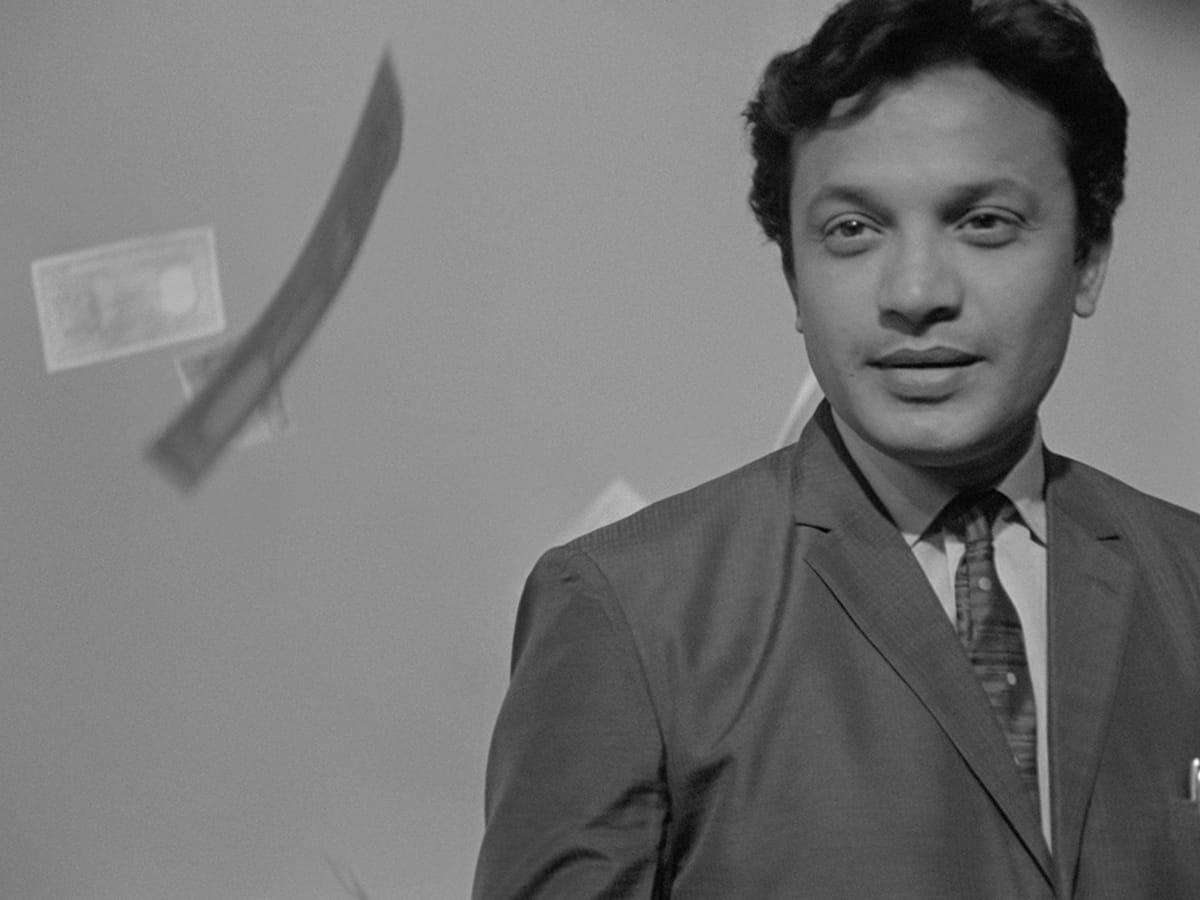The artist Andy Warhol once commented that, “All art is commercial art.” Satyajit Ray’s cinema, however, was steadfastly noncommercial. Ray was a certified auteur who made no concessions to the box office and preserved his personal vision at all costs. Although his films were acclaimed both in India and abroad, they were not as profitable as big Bollywood spectacles or popular Bengali movies.
Therefore, Ray’s 1966 film “The Hero” comes as a surprise. He cast matinee idol Uttam Kumar as the protagonist. Like Kumar, Arindam Mukherjee is also a beloved movie star. All of his films have enjoyed smashing success, and his romantic exploits fill the pages of fan magazines. Still, Mukherjee knows that his status is far from secure. He has a premonition that his latest film will flop, so he takes a train from Calcutta to New Delhi. En route, he meets a young journalist, and when she interviews him, he is forced to reevaluate his life and career.
In conveying Mukherjee’s existential crisis, Ray expounds on Warhol’s statement. He draws attention to the striking parallels between “commercial” art and “high” art. In doing so, he considers the purpose of movies and the insecurity of moviemakers.
In some sense, the hero of “The Hero” is troubled because he has “sold out.” He began his career in the theater and he had modest ambitions; then, he booked a part in a major motion picture. His shrewd mentor cautions him not to become embroiled in the movie industry, claiming that, “There’s glamour in films, but they have nothing to do with art.” Nonetheless, Mukherjee pursues stardom.
Myriad directors have made films on the theme of earning cash at the expense of craft. In Damien Chazelle’s recent musical “La La Land,” Sebastian (Ryan Gosling) is lured away from his love of jazz when Keith (John Legend) promises him financial security. The protagonists in the various versions of “A Star is Born” are all wealthy but creatively moribund, so much so that they seek out an ingénue to revitalize them. While these movies illustrate the repercussions of losing artistic integrity, Ray’s comment on the subject is more complex. His goal in “The Hero” is not simply to demonstrate that films have something to do with art, but to ponder the utility of creating art.
The writer W. Somerset Maugham argued that art was absolutely necessary to human existence because it is “the refuge which the ingenious have invented … to escape the tediousness of life.” Mukherjee’s romantic dramas are certainly not “ingenious,” yet through his acting, he helps ordinary people “escape the tediousness of life.” The other passengers on the train come from different parts of the country and have diverse reasons for embarking on the journey. Yet, Mukherjee’s popular movies serve as a common language. An old codger rails against the immorality of movie stars. An advertising executive’s young wife aspires to act in films, and she is willing to pursue her dream no matter the cost. Mukherjee shares his compartment with a sick child, and after she sees her screen hero, she speedily recovers. Even if Mukherjee feels empty after playing in banal movies, he has helped his fans feel whole. Had he remained in the theater, he never would have possessed this power.
While Mukherjee surmounts the commonplace through his acting, Ray revels in the mundane. The other characters in the film are not stars, and Ray treats them accordingly. They exist on the margins of the movie. Their stories are fractured into fragments, and when they arrive in Delhi, their stories are not resolved. The films that feature Mukherjee are all fantasies, but Ray allows his audience to escape the ordinary simply by rendering it on screen.
Many critics claim that Ray’s faithful portrayal of everyday life is a signature component of his style. These writers usually subscribe to the auteur theory. Andre Bazin, who played a key role in developing the auteur theory, asserted that the auteur “always tells the same story” and has “the same moral judgments on the actors and the characters.” Ray makes “moral judgments” on his characters by depicting their quotidian actions. Yet, if he is always using this technique and always telling the same story, how is he any different from Mukherjee, who plays the same character over and over again?
Bazin also declared that directors are still artists, even if not all of their films are works of art. He reasoned that, “One can accept the permanence of talent without confusing it with infallibility or immunity against making mistakes.” Over the course of the film, Mukherjee accepts what Bazin asserts – that talent is not a safeguard against starring in a flop. “The Hero” was a critical, but not a commercial success. Like Mukherjee, Ray too had his share of failures. The hero of the masses and the hero of movie connoisseurs encounter the same risks as they try to provide a refuge from the tediousness of life. Yet, perhaps Mukherjee and Ray are heroes precisely because they accept these risks and continue to make art – commercial or not.
“The Hero” will screen at SFMOMA on Sunday, Oct. 14.
Contact Amir Abou-Jaoude at amir2 ‘at’ stanford.edu.
